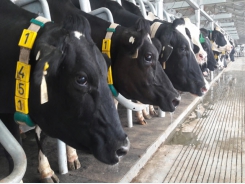Rice exports: Opportunities in traditional markets

Rice exports yielded good results in the first half of 2018 and are expected to further increase towards year’s end due to high demand in traditional export markets.
The latest data from the Ministry of Industry and Trade (MoIT) show that Vietnam exported 3.6 million tonnes of rice worth US$1.83 billion in the first six months of 2018, up two percent in volume and 44.3 percent in value compared with the first half of 2017. In June 2018, the export price of Vietnamese five percent broken rice was US$450 per tonne, higher than export prices of Indian and Thai rice of the same kind.
China remained the largest importer of Vietnamese rice in the first half of 2018 (26 percent of exports). However, due to a decline in importer demand, exports to this market decreased by 27.6 percent in volume and 14.8 percent in value compared with the first half of 2017. The average export price to China was US$532.5 per tonne, up 17.7 percent.
Meanwhile, exports to Indonesia - the second largest importer of Vietnamese rice, grew 45 times in volume and 60 times in value, accounting for 19.7 percent of total export volume and 18.2 percent of total export value. The export price also rose sharply to US$469.5 per tonne.
Exports to other markets, such as Iraq, Malaysia, the US, Hong Kong (China), the Philippines and Ghana, also surged in value.
Experts forecast further rice export increases towards year’s end due to growing demand in traditional markets.
Specifically, from the fourth quarter of this year to the first quarter of 2019, the Philippines, one of the largest importers of Vietnamese rice, will issue a tender for the import of 805,200 tonnes of rice under the 2018 Minimum Access Volume (MAV) scheme. This plan promises Vietnam opportunities to increase rice exports.
Demand from Indonesia and Malaysia is expected to remain stable. Other potential importers include Bangladesh and African countries.
However, Vietnamese rice exporters also have to cope with challenges. At a recent online meeting to summarize rice export results of the first half of 2018 and develop the plan for the second half, Minister of Industry and Trade Tran Tuan Anh indicated possible adverse impacts of China’s strained commercial relations with the US on Vietnamese exports, including rice. He also spoke about the resurgence of protectionism that will heavily affect Vietnam - an economy with a high degree of openness. For example, the US applies self-defense measures; Indonesia and India are willing to violate World Trade Organization (WTO) regulations to protect domestic manufacturers.
To overcome these challenges, Vietnam should improve rice quality further by using good varieties and applying new farming techniques. Mechanization should be promoted to reduce production costs. Vietnam also needs to take advantage of free trade agreements to diversify rice export markets.
The 2018 rice exports are forecast to reach about 6.5 million tonnes in volume, with high-quality products to account for the majority, 80 percent or more.
Có thể bạn quan tâm
Phần mềm

Phối trộn thức ăn chăn nuôi

Pha dung dịch thủy canh

Định mức cho tôm ăn

Phối trộn phân bón NPK

Xác định tỷ lệ tôm sống

Chuyển đổi đơn vị phân bón

Xác định công suất sục khí

Chuyển đổi đơn vị tôm

Tính diện tích nhà kính

Tính thể tích ao hồ



 Startup with 3,000 chickens
Startup with 3,000 chickens  Vietnam near to cracking US$2 billion in cashew…
Vietnam near to cracking US$2 billion in cashew…